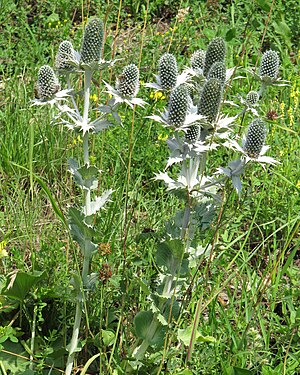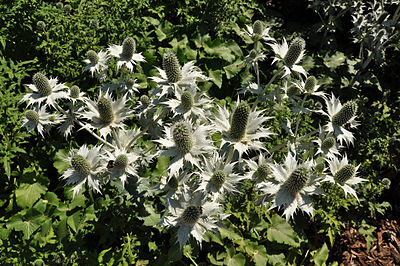Ivory man litter
| Ivory man litter | ||||||||||||
|---|---|---|---|---|---|---|---|---|---|---|---|---|

Ivory man litter ( Eryngium giganteum ) |
||||||||||||
| Systematics | ||||||||||||
|
||||||||||||
| Scientific name | ||||||||||||
| Eryngium giganteum | ||||||||||||
| M.Bieb |
The ivory man litter ( Eryngium giganteum ) (English: giant sea holly , Miss Willmott's ghost ) is a plant species from the umbelliferae family (Apiaceae). It is also called giant man litter and ivory thistle.
description
The ivory man litter is a short-lived, usually biennial plant with a wintering rosette of heart-shaped, rigid leaves. The umbel-like branched inflorescence with a strong stem reaches a height of 70-100 cm and a width of about 80 cm. The flowering period extends from June to August. The flowers are umbels condensed into cylindrical heads with piercing, silvery bracts . After flowering and fruit ripening, the plant usually dies, but retains its external structure into winter.
The number of chromosomes is 2n = 16.
ecology
The flowers of the ivory man litter are pollinated by many types of insects , such as beewolf and bee beetle . Similar to the flowers of the field man litter , they give off a lot of nectar and to a lesser extent pollen .
Occurrence
The ivory man litter is native from northeast Turkey over the Caucasus in Georgia , Armenia and Azerbaijan to northwest Iran , especially in mountainous areas on rocky grass slopes, gravel banks and semi-dry grasslands with calcareous fine soil . In Great Britain and Sweden it is considered naturalized, in Central Europe as an inconsistent neophyte . It grows well in full sun to partially shaded locations with permeable soil, also on the south-facing wooded edges , if the soil does not fall too dry in summer.
use
The ivory man litter is used as an ornamental plant in parks and gardens and is widely visited by insects ( bees , butterflies ). It is suitable as a cut flower and forms beautifully shaped dried flowers . The plant belongs to the short-lived species for sunny, warm places with moderately dry to fresh soils. The species is dependent on a loose stand with open, uncultivated soil in order to maintain itself in a plantation through self-sowing. Like other species of the genus Mannstreu , the plant forms impressive cylindrical inflorescences, which are surrounded at the base by a shell of hard bracts . In garden architecture, the plant is considered a valuable structural plant for the natural garden because of its tall, bizarre inflorescences and the silvery shimmering bracts . Their shiny metallic silver comes into its own in the foreground of dark garden areas. In the famous gravel garden of the British gardener Beth Chatto , ivory man-made litter grew next to the silver-green tufts of Mexican feather grass ( Nassella tenuissima ) and lemon-yellow chamomile .
As is typical for male litter , ivory male litter contains many phytochemicals such as terpenoids , triterpene saponins and flavonoids , which may be medically effective, but whose pharmacological activity (e.g. cytotoxicity ) has not yet been adequately investigated.
Trivia
The English name Miss Willmott's ghost refers to the British gardener Ellen Ann Willmott (1858-1934). She was an influential member of the Royal Horticultural Society , but was considered eccentric and supposedly always carried seeds of the ivory man's litter with her to secretly sow in foreign gardens.
Systematics
The first publication of Eryngium giganteum was made in 1808 by Friedrich August Marschall von Bieberstein in Flora Taurico-Caucasica 1 .
swell
- Richard Hansen , Friedrich Stahl: The perennials and their areas of life. 6th edition. Verlag Eugen Ulmer, Stuttgart (Hohenheim) 2016, ISBN 978-3-8001-8385-2 .
- Leo Jelitto, Wilhelm Schacht , Hans Simon: The outdoor ornamental perennials, manual and lexicon of garden perennials. Volume 1: A to H. 5th, completely revised edition. Verlag Eugen Ulmer, Stuttgart (Hohenheim) 2002, ISBN 3-8001-3265-6 .
- galasearch, plant database of garden architecture: [4] .
Web links
- Ivory man litter. In: FloraWeb.de.
- Thomas Meyer: Data sheet with identification key and photos at Flora-de: Flora von Deutschland (old name of the website: Flowers in Swabia )
- galasearch, plant database of garden architecture: [5]
Individual evidence
- ^ Leo Jelitto, Wilhelm Schacht , Hans Simon: Die Freiland-Schmuckstauden, manual and lexicon of garden perennials: Volume 1: A to H. 5th, completely revised edition. Verlag Eugen Ulmer, Stuttgart (Hohenheim) 2002, ISBN 3-8001-3265-6 , p. 341.
- ^ A b Richard Hansen , Friedrich Stahl: The perennials and their areas of life. 6th edition. Verlag Eugen Ulmer, Stuttgart (Hohenheim) 2016, ISBN 978-3-8001-8385-2 , p. 321.
- ↑ Eryngium giganteum in the Chromosome Counts Database: (ccdb.tau.ac.il)
- ↑ Hilke Steinecke: Wolves in the palm garden. In: Der Palmengarten 83/2, Palmengarten Frankfurt 2019, [1] , pp. 141–143.
- ↑ a b Distribution according to Euro + Med PlantBase: (ww2.bgbm.org)
- ↑ Eryngium giganteum at FloraWeb: (floraweb.de)
- ↑ a b Eryngium giganteum at galasearch: (galasearch.de)
- ^ Nobert Kühn: New use of perennials. Verlag Eugen Ulmer, Stuttgart (Hohenheim) 2011, ISBN 978-3-8001-5970-3 , pp. 141, 173, 181, 207, 229.
- ^ Piet Oudolf, Henk Gerritsen: Dream Plants for the Natural Garden. Frances Lincoln, London 2011, ISBN 978-0-7112-3462-8 , p. 104.
- ↑ Beth Chatto: Draft Resistant Planting. Frances Lincoln, London 2000. ISBN 978-0-7112-1425-5 . P. 86, p. 100.
- ↑ Ping Wang, Zushang Su, Wei Yuan, Guangrui Deng, Shiyou Li: Phytochemical constituents and pharmacological activities of Eryngium L. (Apiaceae). In: Pharmaceutical Crops 2012/3, Bentham Open 2012, [2] , pp. 99-120.
- ↑ Article about Ellen Willmott in the English Wikipedia: [3] .


